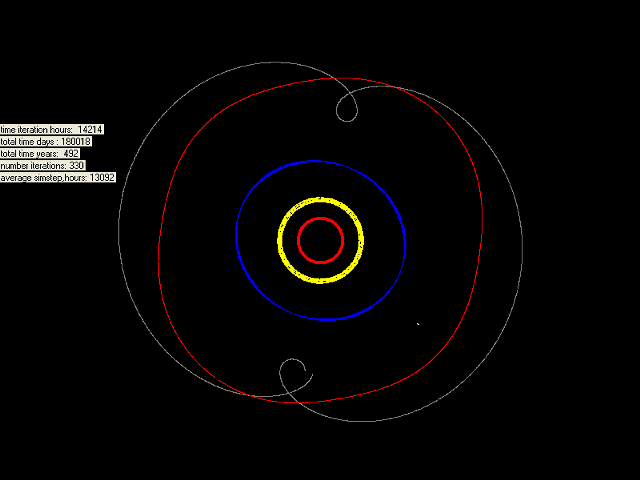
2007 JH43
Encyclopedia
, also written as 2007 JH43, is a trans-Neptunian object
with an absolute magnitude
of 4.7. This may qualify it as a small dwarf-planet candidate. It came to perihelion
around 1888.
Assuming a generic TNO albedo
of 0.09, it is about 500 km in diameter.
It has been observed 32 times over 7 oppositions with precovery
images back to 1984.
(MPC) lists 2007 JH43 as a plutino
(a trans-Neptunian object
in 2:3 mean motion resonance
with Neptune
). But The Deep Ecliptic Survey
(DES) currently shows it as a scattered object
(borderline ScatExt/ScatNear) based on a 10 million year integration of the orbit.

Trans-Neptunian object
A trans-Neptunian object is any minor planet in the Solar System that orbits the Sun at a greater distance on average than Neptune.The first trans-Neptunian object to be discovered was Pluto in 1930...
with an absolute magnitude
Absolute magnitude
Absolute magnitude is the measure of a celestial object's intrinsic brightness. it is also the apparent magnitude a star would have if it were 32.6 light years away from Earth...
of 4.7. This may qualify it as a small dwarf-planet candidate. It came to perihelion
Apsis
An apsis , plural apsides , is the point of greatest or least distance of a body from one of the foci of its elliptical orbit. In modern celestial mechanics this focus is also the center of attraction, which is usually the center of mass of the system...
around 1888.
Assuming a generic TNO albedo
Albedo
Albedo , or reflection coefficient, is the diffuse reflectivity or reflecting power of a surface. It is defined as the ratio of reflected radiation from the surface to incident radiation upon it...
of 0.09, it is about 500 km in diameter.
It has been observed 32 times over 7 oppositions with precovery
Precovery
Precovery is a term used in astronomy that describes the process of finding the image of an object in old archived images or photographic plates, for the purpose of calculating a more accurate orbit...
images back to 1984.
Plutino or Scattered?
As of 2009, the Minor Planet CenterMinor Planet Center
The Minor Planet Center operates at the Smithsonian Astrophysical Observatory , which is part of the Center for Astrophysics along with the Harvard College Observatory ....
(MPC) lists 2007 JH43 as a plutino
Plutino
In astronomy, a plutino is a trans-Neptunian object in 2:3 mean motion resonance with Neptune. For every 2 orbits that a plutino makes, Neptune orbits 3 times. Plutinos are named after Pluto, which follows an orbit trapped in the same resonance, with the Italian diminutive suffix -ino...
(a trans-Neptunian object
Trans-Neptunian object
A trans-Neptunian object is any minor planet in the Solar System that orbits the Sun at a greater distance on average than Neptune.The first trans-Neptunian object to be discovered was Pluto in 1930...
in 2:3 mean motion resonance
Resonant trans-Neptunian object
In astronomy, a resonant trans-Neptunian object is a trans-Neptunian object in mean motion orbital resonance with Neptune. The orbital periods of the resonant objects are in a simple integer relations with the period of Neptune e.g. 1:2, 2:3 etc...
with Neptune
Neptune
Neptune is the eighth and farthest planet from the Sun in the Solar System. Named for the Roman god of the sea, it is the fourth-largest planet by diameter and the third largest by mass. Neptune is 17 times the mass of Earth and is slightly more massive than its near-twin Uranus, which is 15 times...
). But The Deep Ecliptic Survey
Deep Ecliptic Survey
The Deep Ecliptic Survey is a project to find Kuiper belt objects , using the facilities of the National Optical Astronomy Observatory .The principal investigator is Bob Millis....
(DES) currently shows it as a scattered object
Scattered disc
The scattered disc is a distant region of the Solar System that is sparsely populated by icy minor planets, a subset of the broader family of trans-Neptunian objects. The scattered-disc objects have orbital eccentricities ranging as high as 0.8, inclinations as high as 40°, and perihelia greater...
(borderline ScatExt/ScatNear) based on a 10 million year integration of the orbit.

External links
- Orbital simulation from JPL (Java) / Horizons Ephemeris
- 2007 JH43 Precovery Images

